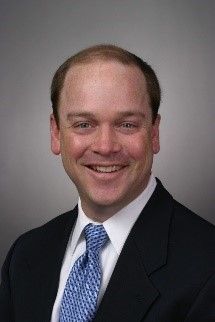Gas Turbine Filtration
A mobile test rig case study
Inland high dust site
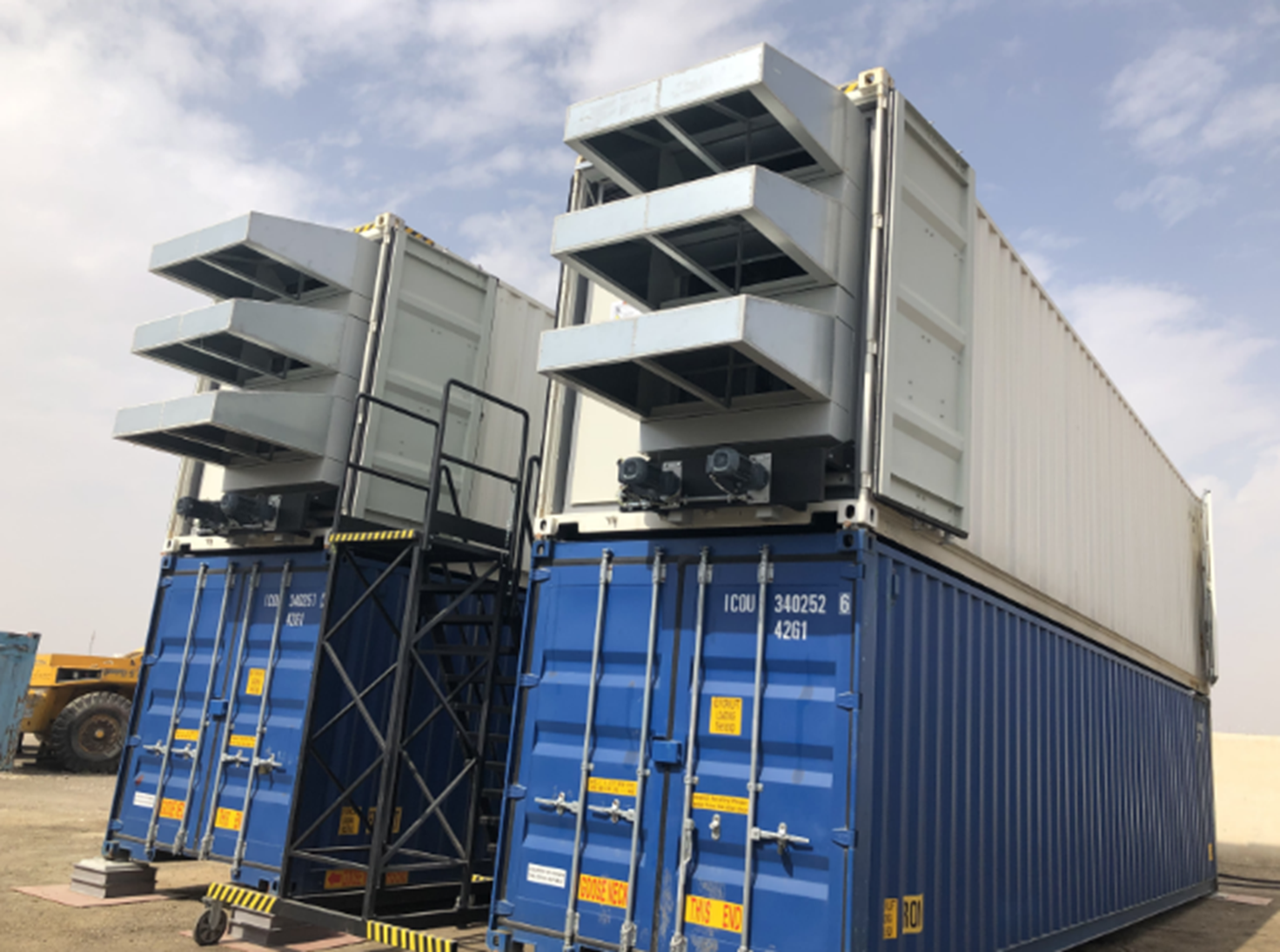
Environmental contaminants affect gas turbine performance. Sand, dust, salt, and other elements present in the huge volumes of air consumed by turbines can impact aerodynamic performance, corrode metal parts inside the machine, and lead to failure. The local environment can contain high volumes of sand, salt if near to the coast, excessive rainfall, elevated levels of moisture from mist, fog, or high humidity levels, or a combination of any of these with seasonal variations.
Inlet filtration houses are installed to protect the machines from contaminants. Their design needs to be specific to the environmental conditions of each installation. But how do we know how filters will perform against real-world conditions? To gain an in-depth understanding, mobile test rigs (MTRs) were deployed across the globe to review the performance of filters in four different environmental conditions: Coastal sites in the northeast of the United States (MTR4) and west coast of the Kingdom of Saudi Arabia (MTR3), as well as inland sites in the Midwest of the United States (MTR2) near its geographic center, and a desert plateau in the center of the Kingdom of Saudi Arabia (MTR1). These provided a range of conditions, namely coastal low dust (MTR4), coastal high dust (MTR3), inland low dust (MTR2), and inland high dust (MTR1). All equipment, flow rates, and filters were standardized.
The study ran for 6,000 fired and instrument hours, covering all four seasons. Performance data and weather conditions were recorded to identify any abnormalities. Each MTR can run multiple stages of filtration, including a coalescer stage in the weather hoods, pulsing cartridge filters, and downstream vCells stage. Each rig is built to run two independent, identical wind tunnels side by side with multiple filters in each stage, enabling direct performance comparisons. At the high-efficiency cartridge stage, it is possible to run six filter sets per wind tunnel, all capable of being pulse cleaned.
As well as comparing known filters in the industry, having two wind tunnels in each MTR provides the capability to develop and try new filter types without putting a gas turbine at operational risk if it was to be tested at a larger scale. Weather conditions that can affect filtration performance are measured, including rain, mist, fog, snow, ice, dust and sand, and wind speed. Each is measured and rated, including droplet size, particle size, relative humidity, and temperature.
COALESCERS
Coalescers are usually installed near large bodies of water, such as oceans, lakes, and rivers. However, one of the larger reactions seen in the MTRs on the pulse filters came from MTR2, an inland low dust test site. Normally such an environment would be classified as benign. But results confirmed that coalescers are beneficial in areas that experience high levels of humidity and fog even where no large body of water exists. As opposed to rain or snow, moisture is formed of tiny water droplets that can become trapped in the matrix of the filter media and cause blockages (Figure 1).
At the MTR3 coastal high-dust installation, the impact of high winds created minor differential pressure increases across the inlet and coalescer stage (Figure 2). Such observations help in the selection and design of filtration systems and GT placement for new power plants.
Figure 1: Differential pressure spikes during mist and fog events without coalescers. Small moisture droplets present in mist and fog can restrict air flow through fine filtration media.
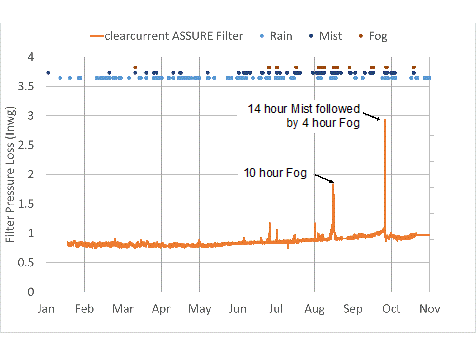
Figure 2: Observed minor pressure increases during high winds at the coastal high dust installation
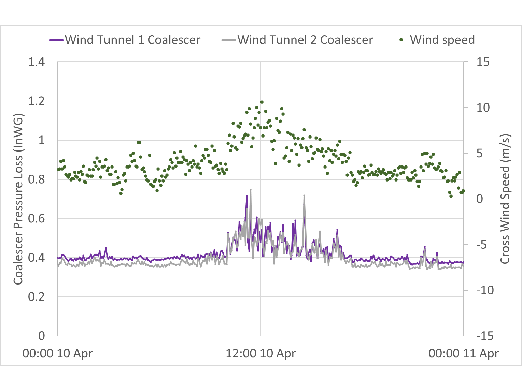
CARTRIDGE FILTERS
The importance of being able to test multiple high efficiency products at the same time can be seen from a trial completed in MTR2 (inland high dust). The test rig had two different filtration product types running, one in each wind tunnel with identical test parameters. After six months of operation, a distinct shift in their effectiveness became evident (Figure 3). As current industry testing standards utilize accelerated test methods using a known type of test dust, they produce radically different results. Thus, such standards may not provide a true comparison of products.
Figure 3: Differential pressure measurement of two products in a high dust environment. For the first six months, performance was similar. After six months, the differential pressure across the industry standard filter rose more rapidly compared with Parker clearcurrent ASSURE filters.
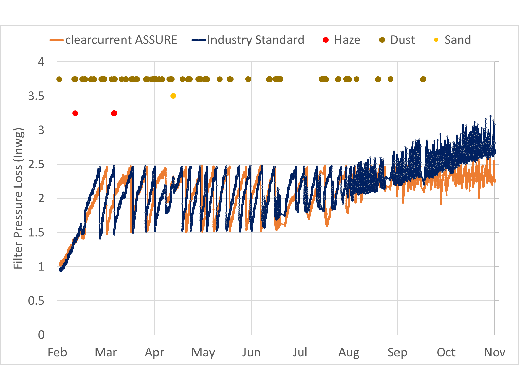
The effect of snow, ice and moisture can be seen at the MTR4 (coastal low dust site) (Figure 4). The results showed sharply different reactions to moisture over time that produced differential pressure spikes.
Figure 4: Differential pressure measurement of two products in a moisture-rich environment (MTR4).
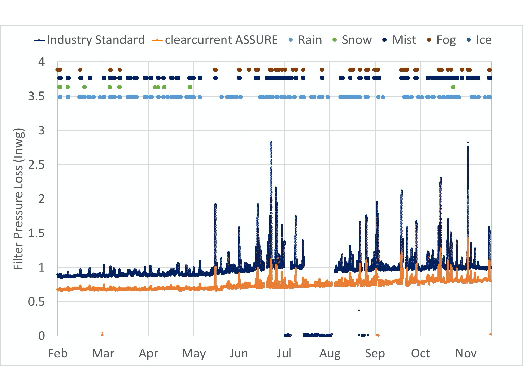
The industry standard filter experienced a greater reaction to moisture over time, producing differential pressure spikes. Such events could lead to de-loading of the gas turbine.
Parker clearcurrent ASSURE Filters protecting latest generation gas turbines.
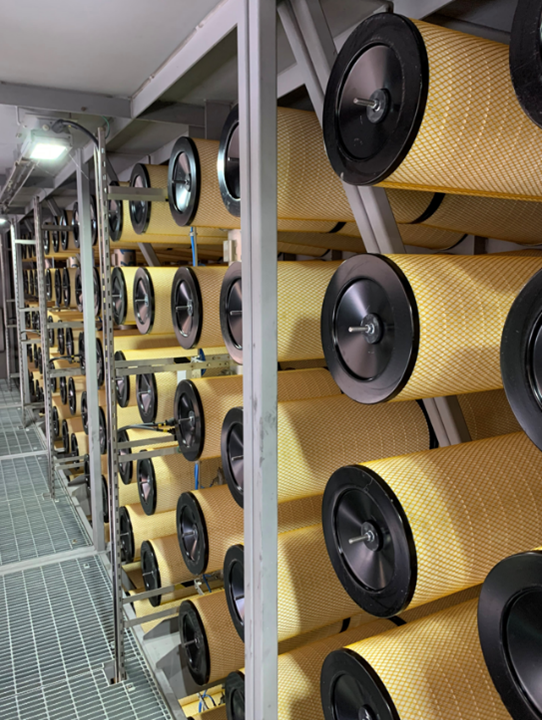
SUMMARY
In what appears to be low-moisture risk (inland low dust) regions, there was a consistent reaction to moisture, showing the benefits of installing coalescers. Without coalescers, the inland low dust site’s reaction to moisture is more pronounced than coastal sites in similar conditions with coalescers. The impact of winds on the coalescer stage was also a notable learning from the data set. The measured wind and associated increase in differential pressure was significant enough that OEMs should consider this when installing new gas turbines.
Ultimately, a filtration solution needs to protect high-performance gas turbines from different contaminants, seasonal variants, and distinctive environmental conditions. While lab testing provides some guidance, it does not replace testing in real-world conditions. ■
Tim Nicholas is PowerGen Market Manager, Gas Turbine Filtration Division, Parker Hannifin, whose clearcurrent ASSURE filters provide protection and performance for advanced gas turbines.
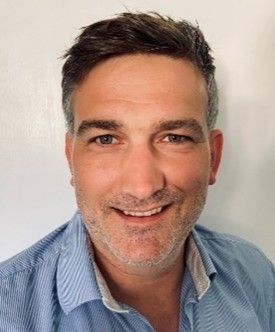
Jim Lenox is Senior Product Manager, Gas Turbine Filtration Division, Parker Hannifin. For more information visit parker.com
